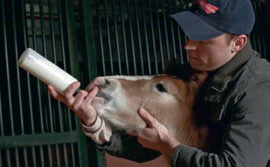Not on a roll
I don’t know how many people have participated in the Andrex scrunch-or-fold ‘debate’ since it launched just over a month ago. Those willing to ‘vote’ on their routine lavatorial tendencies must surely be few and, whoever they are, they constitute a group for which the term ‘get a life’ might have been specifically created.
I am on firmer ground reporting the marketing-industry poll on the sense, or otherwise, of this strange initiative. Managers at Kimberly-Clark should brace themselves, since those who vote it one of the saddest and most insane acts of brand self-harm ever conceived vastly outnumber those with anything remotely positive to say about it.
The industry conversation has served to reignite a more edifying, and long-smouldering, debate on the merits of ‘interruptive’ versus ‘engagement’ communications.
The professional consensus is that Andrex marketers have succumbed to the hype that declares the interruption model dead, a one-way street in a two-way world; wide-eyed and dazzled, it seems, they have bought in to the whole zeitgeist-engagement thing, whereby the task of promoting the brand is devolved to consumers themselves.
What Andrex marketers have actually done, though, is sillier even than that – since their ‘social’ initiative merely diverts the brand’s ‘interruption’ budget to different ends.
How have we all become aware of this ‘national scrunch-or-fold divide’? It is not because of a – there’s no way to avoid this – bottom-up swell of consumer chatter. The ‘debate’ was instead launched in the most traditional way, with £3m of TV and outdoor ads – about as interruptive as media gets.
Let’s reduce this to its elemental truths. Andrex has, for decades, used interruptive communications to persuade us of highly desirable and brand-specific virtues: softness, comfort, length, and general all-round fluffiness.
It now switches to deploying that same interruptive technique to the communication of an ersatz debate on a generic, if bizarre, topic: the origami of bottom-wiping.
In so doing, it does not merely ignore its long-established codes of nurture, warmth and safe care, it subverts them. Coarse, ugly and laddish, this initiative might have made sense as a guerrilla assault by an unknown brand, but promotes a horrible cognitive dissonance from a trusted, family-brand leader.
The ads also break the unspoken contract by which we all permit the intrusion of toilet branding, while eating our fajita TV-supper, just so long as it has the good sense to be agreeably euphemistic. Now, as we are compelled to picture one end while stuffing the other, Andrex opens a whole new communications genre: antisocial media.
How do you explain work like this? Who let it out of the junior-creative playpen? Perhaps Andrex simply tired of being the brand equivalent of a national treasure, and yearned to venture into the dark city cesspits in a hoodie, and to hell with who happened to be watching.
This campaign is probably an aberration, forgivable enough in light of the insistent ‘Everything-has-changed’ engagement mantra. Conceivably, though, it has been set down as part of a carefully documented, ongoing ‘social’ strategy. If so, whether scrunched or folded, there is only one place it belongs.
Scrunching versus folding is not the only topic consumers have been asked to cast their vote on, all in the name of so-called ‘engagement’. In fact, it’s a familiar tactic among consumer brands.
Last month, McDonald’s threw its hat into the voting ring with an online initiative called ‘The one and only’. The campaign asked people to vote for their favourite of the five classic McDonald’s menu items – Big Mac, Quarter Pounder, fries, milkshake or Chicken McNuggets – and to explain why. After submitting their choice, voters can see a word cloud of popular reasons.
Last year, Kit Kat Chunky trialled four flavours and asked for consumers’ vote on which variant should stay on permanently. Peanut Butter emerged as the champion. The 2013 round is now under way.

Budweiser invited fans to name a foal
Back in 1999, Kellogg ran a £5m TV and web campaign asking whether its chocolate cereal should be named Coco Pops or Choco Krispies. Coco Pops stormed to a landslide victory, with more than 92% of the public vote.
Budweiser asked the US public to name the three-week-old foal featured in its Super Bowl spot last month. ‘Hope’ prevailed as the winning name, ahead of others such as ‘Landslide’ and ‘Stevie’.
